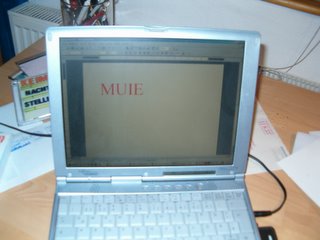The history of COOL

IS MY PHOTO COOL OR LAME???
"Just as the history of cool in AMerica is really ( as many have argued ) a history of African-American culture - from jazz and blues to rock and roll to rap - for many of the superbrands, cool hunting simply means black-culture hunting. Which is why the cool hunters' first stop was the basketball courts of America's poorest neighbourhoods". (NO LOGO)
Interesant, nu? Niciodata nu m-am gindit suficient de mult la o asemenea conexiune.
In orice caz autoarea Naomi Klein vorbeste despre o intreaga retorica a coolness-ului. Cum de fapt "cool" a devenit cuvintul de pe buzele oricarui tinar. "Am i cool enough?"; "Do you think this is cool or lame?". Cum corporatiile producatoare de haine&accesorii&incaltaminte au inceput sa vineze coolness-ul ( cool hunters ) coborindu-se pina in scoli si spionind orizonturile si asteptarile adolescentilor. Apoi cum tinerii agenti ai lui "cool" au fost ei insisi angajati in marile companii in detrimentul altor persoane mai in virsta. Important era ca starea de coolness sa ramina vie dar si capturata in interiorul politicilor de marketing.
O sa reproduc in continuare un pasaj intreg din carte care descrie acest proces.
COOLING THE WATER COOLER
The journey to our current state of world cool almost ended, however, before it really began. Even though by 1993 there was scarcely a fashion, food, beverage or entertainment company that didn't pine for what the youth market promised,many were at a loss as to how to get it.
At the time that cool-envy hit, many corporations were in the midst of a hiring freeze, recovering from rounds of layoffs, most of which were executed according to the last-hired-first-fired policies of the late-eighties recession. With far fewer young workers on the payroll and no new ones coming up through the ranks, many corporate executives found themselves in the odd position of barely knowing anyone under thirty years old. In this stunted context, youth itself looked oddly exotic - and information about Xers, Generation Y and twenty-somethings was suddenly a most precious commodity.
Fortunately, a backlog of hungry twenty-somethings were already in the job market. Like good capitalist, many of these young workers saw a market niche: being professionaly young. In so many words, they assured would-be bosses that if they were hired, hip, young countercultures would be hand-delivered at the rate of one per week; companies would be so cool, they would get respect in the scenes. They promised the youth demographic, the digital revolution, a beeline into convergence.
And as we now know, when they got the jobs, these conduits of cool saw no need to transform themselves into clone-ish Company Men. Many can be seen now, roaming the hallways of Fortune 500 corporations dressed like club kids, skateboard in tow. They drop references to all-night raves at the office water cooler ( "Memo to the boss: why not fill this thing with ginseng-laced herbal iced tea?). The CEOs of tomorrow aren't emplyees, they are, to use a term favored at IBM, "change agents". But are they impostors - scheming "suits" hiding underneath hip-hop snowboarding gear? Not at all. Many of these young workers are the real deal; the true and commited product of the scenes they serve up, and utterly devoted to the transformation of their brands. Like Tom Cruise in Jerry Maguire, they stay up late into the night penning manifestos, revolutionary tracts about the need to embrace the new, to flout bureaucracy, to get on the Web or be left behind, to redo the ad campaign with a groovier, grittier feel, to change quicker, be hipper.
ANd what do the change agents' bosses have to say about all this? They say bring it on of course. Companies looking to fashion brand identities that will mesh seamlessly with the zeitgeist understand, as Marshall McLuhan wrote, "When a thing is current, it creates currency." The change agents stroke their bosses' middle-aged egos simply by showing up - how out of touch could the boss be with a radical like this on the same intranet system?
Just look at Netscape, which no longer employs a personnel manager and instead has Margie Mader, Director of Bringing in the Cool People. When asked by Fast Company, "How do you interview for cool?" she replied, "...there are the people who just exude cool: one guy skateboarded here for his interview; another held his interview in a roller-hockey rink.
At MTV, a couple of twenty-five-year-old production assistants, both named Melissa, co-wrote a document known as the "Melissa Manifesto", calling on the already insufferably bubbly channel to become even more so. ( "We want a cleaner, brighter, more fun MTV", was among their fearless demands. ) Upon reading the tract, MTV president JudyMcGrath told one of her collegueas, "I feel like blowing everybody out and putting these people in charge." Fellow rebel Tom Freston, CEO of MTV, explains that "Judy is inherently an anti-establishment person. Anybody who comes along and says, "Let's off the pig", has got her ear.

0 Comments:
Post a Comment
<< Home